How to Build a Tiny Software as a Service (SaaS) with Very Few Skills
Nobody has to build the next Facebook or TikTok.
Are you familiar with Kevin Kelly’s essay “1,000 True Fans”?
The former editor of Wired Magazine writes about how finding your niche and serving a limited number of people with an exceptional product which is just tailored to them specifically can be more rewarding and more easily attainable. It’s a fallacy to think that true success is only possible if you reach millions upon millions with a generic product that caters to everyone and no one.
I think that’s a valuable lesson for anyone who has a plan to put a new product or service out into the world.
The story of Speechbox starts on a spring weekend in 2007. I was living in Munich at the time and worked as an intern at a small television station which produced content about video games, aptly and creatively named “Games Television”.
It was a chaotic, unstructured place and I had no prior knowledge or intuition for going about the task of establishing myself in that team and becoming a helpful part of it. No one had the time or patience to teach me things, so I ended up improving the official website, because that’s what my skillset allowed for.
Once that was basically done, the idea came into my head to use my time to create a small “software as a service” tool. A little chat widget that website owners could put into their sites in order to chat with visitors and build community that way.
I didn’t think about the possible business opportunities or market situation at the time, it just sprung into my mind that I knew how to build it in its basic form so that people could benefit from it. So I started.
The core functional version was done in a weekend, using standard HTML/CSS for the frontend and some PHP for functionality and a MySQL database to store information. Certainly, my few years of experience in building websites helped, but the skills needed for it could have been learned in a few months from scratch, I believe. Over the next few weeks I used some of the idle time at the internship to improve the code. No one at the television station noticed or cared. Then I quit and took up a different job, this time as a remote web developer for a Berlin company while still living in Munich. More money, more freedoms.
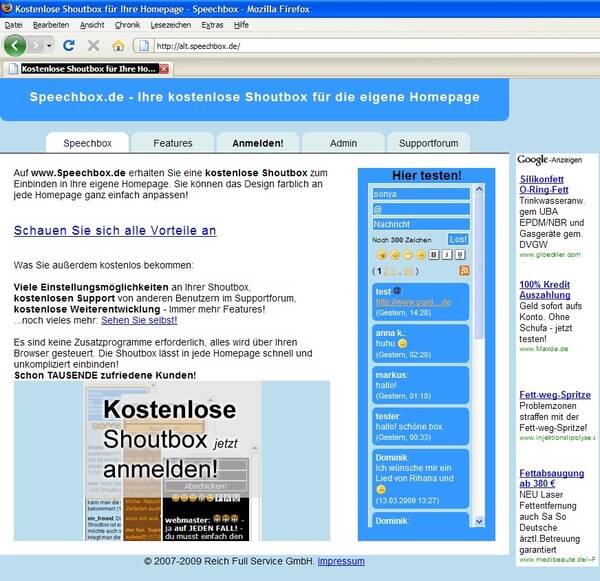
Speechbox lived on as a little side project, and somehow surprising even myself, signups came in without me doing anything. The German language keywords “kostenlose shoutbox” (i.e. “free shoutbox”) were still in people’s heads when they searched for a little chat widget and I had carefully put those words into the heading. Because the software did what it said it did, people started using it and some web portals even included Speechbox as a fun tool for people starting their own websites, free of charge and without me even asking. From then on, the ball started rolling.
A couple friends noticed the unlikely success and suggested ways in which to improve it. I always gladly accepted. A year later, a co-worker at the new Hamburg company I was now working at suggested to include backlinks to the shoutboxes from within the users’ websites using the code snippets needed to include the shoutbox. Clever and not too annoying for anyone, this improved the SEO situation even further and Speechbox climbed to the very first results page, increasing the signups some more. Still, no money spent.
In 2009 then, I decided to take the little side project a step further and introduced the paid Premium functionality, effectively making Speechbox a “Freemium” service. Free to use and offering paid additional features. My friend Andreas, whose position is now Cloud Infrastructure Consultant at AWS, helped me set this up. It was a simple PayPal button which made use of the Instant Payment Notification feature to create a receipt, send that out to the user, and change the Premium flag in the database from 0 to 1. Andreas had fun writing code for some more features here and there.
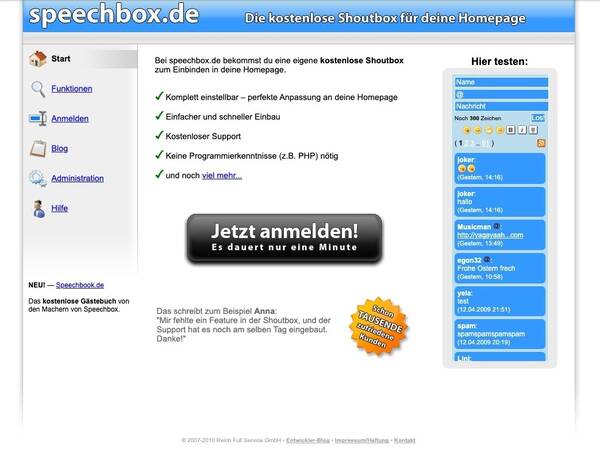
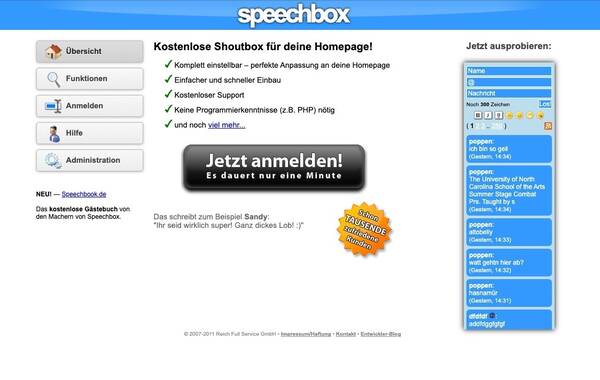
The main feature that we started to offer only to paying users is the realtime chatting ability. At the time, this was difficult to engineer and required a separate service to push out new messages and let clients become “subscribers” to newly pushed out messages, the publish-subscribe messaging pattern. We switched services a bunch of times over the years as these were often quite costly, especially when our active user numbers increased. During the first few months we actually lost money on that front.
But it was fun to do and see how so many people enjoyed using the little chat I built. Some months, we had the page views cross over into 10 million and there were tens of thousands of active shoutboxes.
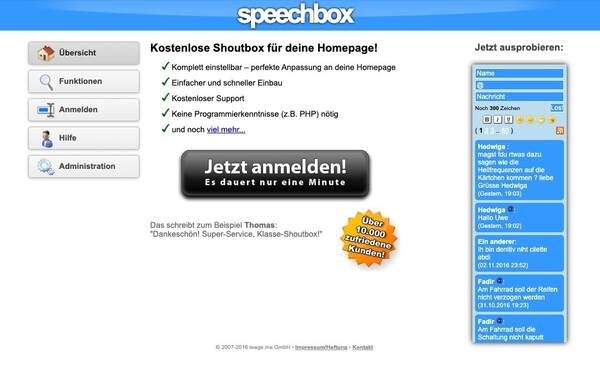
After about a year, the paid upgrades started to outweigh the server cost and publish-subscribe messaging service we had to pay for. The service raked in a few hundred bucks a month, in bad months a bit under a hundred. There were somewhere around a hundred paying users. It was humming along nicely. I did all the user support communications myself and sometimes fixed a few bugs here and there, but in general the software stayed the same for many years to come.
I always saw more potential in the tool, especially since it’s been German language only while people all over the world build their own private websites and would like to chat to visitors on them, even though the methods of messaging each other exploded due to the advent of smartphones right when Speechbox started.
Talking to visitors with common interests who arrived at your topical little website can be very interesting!
No one of my business contacts really took the niche seriously though, probably because it seemed so small. Whenever I told someone about this side project, I received skeptical feedback. It’s not cutting edge, it will never be huge, you’re wasting your time with something that’s on the way out and replaced by social media.
But suddenly, an opportunity arose. People started to use chat widgets on their websites to communicate one to one with single visitors who have questions about something on that website. It was mostly used by e-commerce websites selling something and trying to help visitors in order to turn them into customers. This would have been the time to slightly alter my software to allow for that one to one communication and enter the lucrative market of the “support chat tool”, as many other companies did.
Unfortunately, I wasn’t able to make use of the opportunity. I was running my own web design business with some employees at the time and didn’t have any spare money to spend on engineers to build this. In addition, I was missing knowledge, experience, and courage to go and get some capital to do it. And the free time to build an MVP (minimum viable product) myself at home had decreased a lot, too, since my four kids were born starting in 2011. So that ship sailed away, me watching it longingly disappear. Signups and upgrades slowly declined even though Speechbox had by now taken the top spot on search engines for our most important keywords.
Speechbox was still close to my heart even though I couldn’t spend much time on it. Because running my company required me to take care of making enough monthly income to pay the salaries and we were on a project to project basis, there was not much spare time. At some point, after having maintained Speechbox privately and through my friend Andreas’ company for a while, I inserted the Speechbox project into my own company, mostly to make taxation easier.
In 2018, one of my developers, Maxim, rebuilt the publish-subscribe functionality from scratch to be more efficient. It now required just minimal server cost without having to rely on an outside service provider at all anymore. This was a huge leap forward and reduced the monthly cost required to run Speechbox to less than 10% of what it was before.
Finally, in 2021, a tiny opening presented itself and I and my team did a visual refresh of Speechbox. My designers Nic and Martin made it look nicer and developers Joscha and Maxim took care of some under the hood stuff.
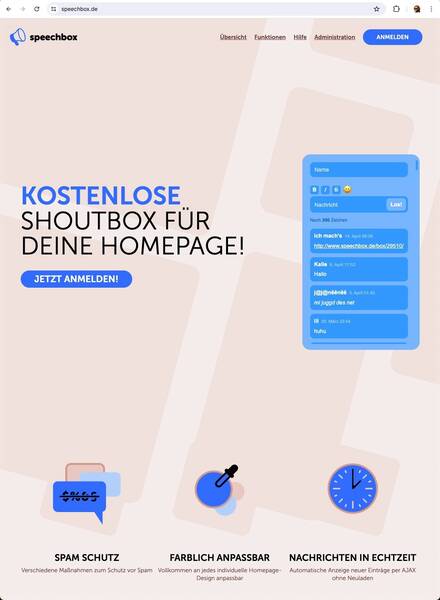
We didn’t introduce anything new, really, so the user feedback was lukewarm. It was supposed to lay the foundation to build it all out, but we never found the time subsequently.
The doubts, which were part of me for so many years, stayed.
Is Speechbox doomed to fail? After the sudden success many years ago, is this thing on a downward spiral because too few people have a real need for it? Will a tool like this be obsolete in a few years?
I still refuse to believe this.
I think what made the internet great is the ability that everyone can build their own website to put things into the world which are interesting to them, and do so on their own terms. During the past twenty years, huge platforms have tried and mostly succeeded to grab us and put us into their golden prisons so we publish things interesting to us into databases they own, so they can profit off of the content.
To many people, this doesn’t feel quite right.
Thankfully, the community around building independent websites is still very strong, with the open source software WordPress at its center. A third of the world’s websites are powered by it.
And it still warms my heart when someone builds a website about a hobby of theirs and shares their knowledge this way, even though it seems like an uphill battle in trying to reach any like-minded people when everyone is doom-scrolling Instagram. The personal website deserves more attention than it currently receives, but that goes against the interests of big and powerful tech companies. We can’t know how it will play out over time, but we do have a hand in shaping the future, always.
If a tiny chat tool inserted into a personal website helps redirect attention to the people who independently put great content into the world, I’d like to remain an assisting force to that cause.
Which is why, when I sold my company at the end of 2023, in the negotiations I asked for getting to own Speechbox privately again.
Starting in 2024, with my newly freed time from the company sale, I started to do a full rewrite, do the design in a way that I think helps the product, add some features, and introduce the most important new feature: international localization. Starting with English and German for the main landing page and six more languages for the Speechbox tool itself. This way, I would potentially reach a much bigger audience of independent website owners.
Working nearly every day on it, here’s what I did as my Quarter 1 of 2024 project.
January
- Moved the legacy code from servers owned by my former company to my own two servers. This was a huge task, taking at least three weeks.
- Fixed a bunch of old small bugs, implemented Markdown support for messages, got to know the code which has by now been written by half a dozen different people.
February
- Designed and developed a new and improved dashboard for the website owners to customize their shoutbox’s design, adjust general settings, insert custom Emoji, view analytics, ban users and delete messages.
- Designed and developed a new landing page to showcase the Speechbox software with some concise and visually appealing attributes, made it short and playfully colored to appeal to the customization options which website owners like.
- Wrote all content for the many subpages, coded the user management, fully finished the landing page.
- Removed the PayPal-only prepaid Premium upgrades and replaced them with an automatic subscription that uses global payment provider Stripe. This was new to me and required lots of time getting used to, but it makes everything so much easier for everyone.
March
- Finalized the German localization of the dashboard and landing page. (I started it all using only English)
- Rewrote the full shoutbox code to be more efficient and more easily expandable in the future. Some libraries I used in 2007, like the Smarty Template Engine, just had to finally go.
- In general, I tried to use as little foreign code libraries as possible, so nothing would need to get upgraded and potentially break in the future. Optimizing for less maintenance.
- Rewrote the client-side code for communication of the shoutbox with the realtime messaging server, improved some of the server code.
- Added language support in the shoutbox for English, German, Italian, Spanish, French, Dutch, Polish, and Portuguese.
- Added an often requested feature: optional sound notifications on new messages. Finally!
- Fixed countless new bugs I introduced in the past three months and polished it all some more.
And last not least, I published it all at www.speechbox.chat
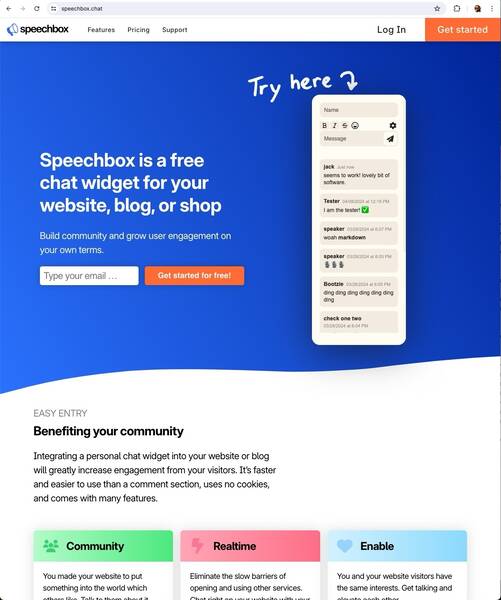
It felt really good to put out this new and improved version of the tool I had first built 17 years ago. It’s obviously far from perfect, but I’m proud of it.
Even such a seemingly tiny project requires thousands upon thousands of lines of code, and countless little things to track and take care of at all times. Everything I newly build and implement has the potential to mess with something else in the code, so testing requires a lot of time as well. You really need to think of everything all at once and that’s not easily done. I used my favorite management app Notion to keep track of all the little details and tasks but still some bits slipped through the cracks here and there. At times it was an uphill battle and required lots of perseverance to go through with it, but I was glad to have been aware of the Pareto Principle (20% of the work gets 80% of the results) and Parkinson’s Law (the work takes as long as you assign to it).
It’s very easy to lose yourself in tasks which are complex but don’t benefit the whole project in the big picture that much. I often needed to remind myself to stop, think, and switch tasks. And while it’s generally fun to me to build and explore new technologies, finishing such a project all by yourself also requires you to do the tedious parts which feel like work and aren’t interesting. You just need to get on with it despite that if you would like to reach the finish line. That’s something I’ve reenforced in my personality because of my love for ultra running.
It was highly rewarding to manage to tick off that project on time, but as with everything, there’s always more work to do. The list of things I’d like to improve at Speechbox is very long. Among the first ones is building a WordPress plugin, so users can even more easily add a Speechbox chat into their WordPress website without any need to copy and paste the code snippet. Then, I’m thinking about doing some type of advertising measures for the international market, but haven’t decided on what exactly, yet. I’m open to and thankful for suggestions!
Over the coming months and years, I’d like to implement landing page language support for a few more countries, e.g. French, Spanish, and Dutch, and build a lot more of the countless feature ideas I’ve got in my Notion database.
While I’m thankfully not dependent on making any profit off of Speechbox, I’d like to increase the number of paying customers from currently about 50 to reach the bespoke 1,000 True Fans with it. I think that’s possible, especially since the current 50 subscribers are all based in Germany due to the fact it used to be German only for so long. Maybe my strategy has to change and evolve for it to happen, I don’t know. I will find out along the way, because the journey is what it’s about.
How do you feel after reading this?
This helps me assess the quality of my writing and improve it.
Leave a Comment